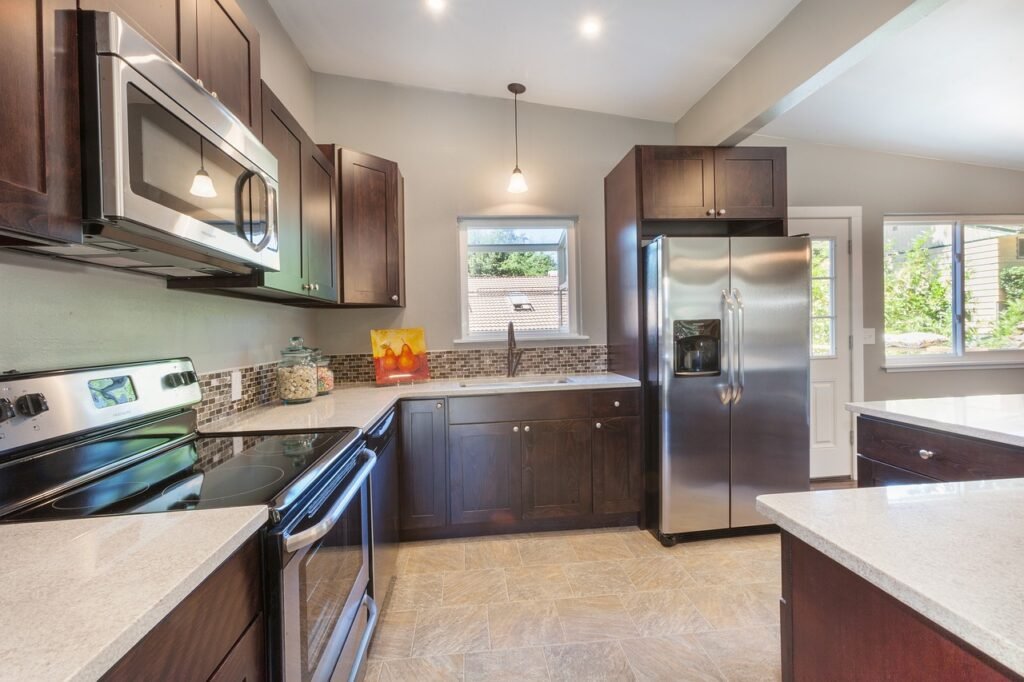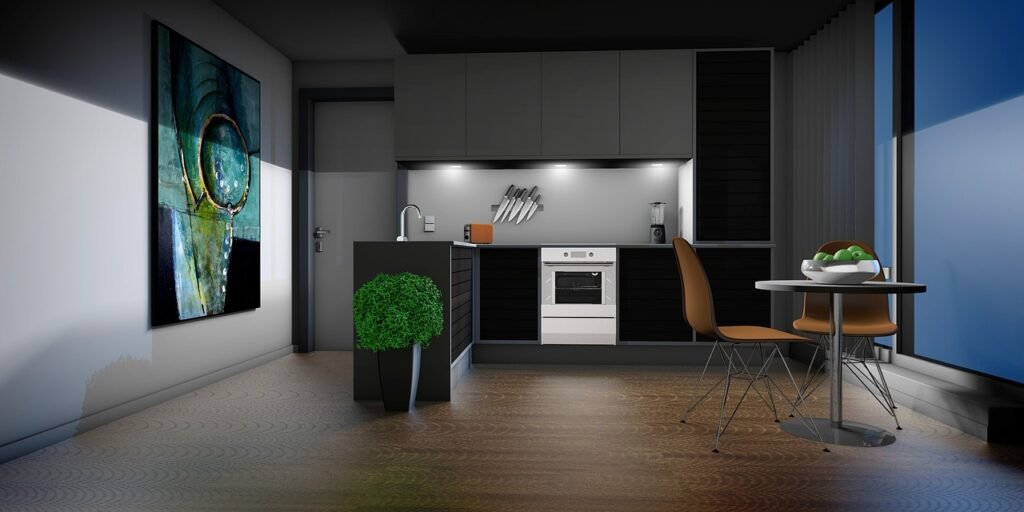You know that feeling when you step into a beautifully lit kitchen and instantly feel at ease? Well, imagine creating that same warm and inviting atmosphere in your own kitchen. In this article, we will explore the best practices for enhancing your kitchen’s ambiance with effective illumination. From choosing the right lighting fixtures to finding the perfect balance between task and ambient lighting, we’ve got you covered. So, get ready to transform your kitchen into a welcoming space that is both functional and visually stunning.
Choosing the Right Lighting Fixtures
When it comes to choosing the right lighting fixtures for your kitchen, there are a few factors to consider. First, think about the size and layout of your kitchen. A larger kitchen may require more lighting fixtures to ensure adequate coverage. Additionally, consider the specific areas where you need light the most, such as the countertop, sink, or stove. By understanding the different lighting needs in your kitchen, you can make a more informed decision about the fixtures that will suit your space best.
Consider the size and layout of your kitchen
The size and layout of your kitchen play a crucial role in determining the number and placement of lighting fixtures. A larger kitchen will require more fixtures to ensure that every corner is well-lit. On the other hand, in a smaller kitchen, you can opt for fewer fixtures, focusing more on strategic placement to maximize the lighting. Consider the overall design and layout of your kitchen to determine where the main focal points are, and place lighting fixtures accordingly.

This image is property of pixabay.com.
Determine the amount of light needed
Next, consider the amount of light needed in your kitchen. This will depend on the tasks you typically perform in the space. If you use your kitchen primarily for cooking and food preparation, you’ll need brighter task lighting in areas such as the countertop and stove. However, if your kitchen is also a gathering space, you’ll want to incorporate ambient lighting to create a warm and inviting atmosphere. By determining the specific lighting needs of your kitchen, you can ensure that your lighting fixtures provide the right amount of light.
Evaluate different types of lighting fixtures
There are various types of lighting fixtures available, each with its own unique characteristics and benefits. Some popular options include recessed lighting, pendant lights, chandeliers, and track lighting. Each type of fixture offers different lighting effects and styles, so it’s important to consider both the aesthetic and functional aspects when making your choice. Take the time to research and evaluate each type of lighting fixture to see which one aligns best with your kitchen design and lighting goals.

This image is property of pixabay.com.
Mix and match different light sources
To create a layered and visually appealing lighting scheme, consider mixing and matching different light sources in your kitchen. Combining ambient, task, and accent lighting can enhance the overall ambiance and functionality of the space. For example, you can install recessed lights for general lighting, pendant lights above the island for task lighting, and under-cabinet lights for accent lighting. By incorporating a variety of light sources, you can create a dynamic and versatile kitchen lighting design.
Optimizing Natural Light
Maximizing the use of natural light in your kitchen can significantly enhance its ambiance and energy efficiency. Here are some tips for optimizing natural light:
Maximize windows and skylights
If your kitchen has windows or skylights, make the most of them by keeping them clean and unobstructed. Remove any heavy curtains or blinds that may block the light and consider opting for lighter window treatments that allow light to pass through more easily.
Use light-colored or translucent window treatments
If you prefer some privacy but still want to allow natural light to enter your kitchen, consider using light-colored or translucent window treatments. These options can filter the light while still creating a bright and airy atmosphere in the space.
Position mirrors strategically
Placing mirrors strategically in your kitchen can help reflect and distribute natural light more effectively. Consider installing a mirror on a wall opposite a window or skylight to bounce the natural light around the room and create a brighter and more spacious feel.
Consider installing a light shaft
For kitchens located in areas with limited access to natural light, such as in the center of a building, consider installing a light shaft. A light shaft is a vertical shaft built into the structure, allowing natural light from a roof or exterior wall to enter the kitchen. This can be a great way to bring in additional natural light and brighten up the space.

This image is property of pixabay.com.
Layering Light Sources
To create a well-lit and visually appealing kitchen, it’s essential to understand the concept of layering light sources. By incorporating different types of lighting fixtures, you can achieve the perfect balance of task lighting, ambient lighting, and accent lighting. Here’s how to effectively layer light sources in your kitchen:
Understanding the three layers of kitchen lighting
The three layers of kitchen lighting are general or ambient lighting, task lighting, and accent lighting. General lighting provides overall illumination to the entire space, while task lighting is focused on specific work areas, such as the countertop or stove. Accent lighting, on the other hand, is used to highlight certain points of interest or decorative features in the kitchen.
Installing general or ambient lighting
General or ambient lighting serves as the primary source of illumination in your kitchen. This can be achieved through recessed lighting, flush-mount fixtures, or track lighting. By evenly distributing general lighting throughout the space, you create a well-lit and visually balanced environment.
Incorporating task lighting for specific work areas
Task lighting is crucial for providing focused and direct light in areas where specific tasks are performed. This includes under-cabinet lighting, pendant lights above the island, or strip lights installed beneath shelves. By incorporating task lighting, you can ensure that your work areas are well-illuminated, making tasks like food preparation and cooking easier and safer.
Adding accent lighting to highlight focal points
Accent lighting is used to create visual interest and draw attention to specific elements in your kitchen, such as artwork, architectural features, or decorative objects. This can be achieved through the use of spotlights, wall sconces, or adjustable track lighting. By strategically placing accent lighting, you can create a visually appealing and dynamic kitchen space.
Selecting Bulbs with the Right Color Temperature
The color temperature of bulbs can significantly impact the ambiance of your kitchen. Here are some tips for selecting bulbs with the right color temperature:
Understanding the concept of color temperature
Color temperature is a measurement that describes the color appearance of a light source. It is measured in Kelvin (K) and can range from warm (lower Kelvin values) to cool (higher Kelvin values). Warm white light creates a cozy and inviting atmosphere, while cool white light provides a brighter and more energetic ambiance.
Opt for warm white bulbs for a cozy ambiance
If you want to create a warm and intimate atmosphere in your kitchen, opt for bulbs with a warm white color temperature of around 2700-3000K. These bulbs will emit a soft and gentle light that is perfect for creating a cozy and inviting ambiance.
Choose cool white bulbs for a brighter and more energetic atmosphere
If you prefer a brighter and more energetic atmosphere in your kitchen, choose bulbs with a cool white color temperature of around 3500-4500K. These bulbs will emit a crisp and vibrant light that can help increase focus and productivity in the space.
Consider dimmable bulbs for adjustable lighting
To have more control over the lighting in your kitchen, consider using dimmable bulbs. Dimmable bulbs allow you to adjust the brightness according to your needs and preferences, whether you want a soft and romantic glow or a bright and well-lit space. Dimmable bulbs can also help save energy by lowering the level of light when full brightness is not necessary.

This image is property of images.pexels.com.
Utilizing Under Cabinet Lighting
Under cabinet lighting is a practical and stylish way to enhance the overall illumination and functionality of your kitchen. Here are some reasons why you should consider utilizing under cabinet lighting:
Benefits of under cabinet lighting
Under cabinet lighting provides direct and focused light onto the countertop, making it easier to see and work on food preparation tasks. It can also create a warm and inviting ambiance in the kitchen, especially in the evenings or when entertaining guests. Additionally, under cabinet lighting can serve as a subtle night light, making it easier to navigate your kitchen during late-night visits.
Types of under cabinet lighting
There are several types of under cabinet lighting options to choose from, including LED strip lights, puck lights, and linear light bars. LED strip lights are versatile and can be easily concealed underneath cabinets, while puck lights provide more concentrated light in specific areas. Linear light bars are sleek and offer a wider and more uniform distribution of light.
Installation tips
When installing under cabinet lighting, make sure to carefully plan the placement to ensure even and effective illumination. Consider placing the lights towards the front of the cabinets to minimize shadows on the countertop. Also, pay attention to the wiring and power source, ensuring that it is safely and correctly installed.
Creative uses of under cabinet lighting
In addition to providing functional lighting, under cabinet lighting can also be used creatively to enhance the design of your kitchen. For example, you can install color-changing LED strips to create a dynamic and vibrant atmosphere. You can also use under cabinet lighting to highlight specific decorative elements, such as a collection of wine glasses or a beautiful backsplash.
Installing Pendant Lights
Pendant lights are a popular choice for adding style and charm to a kitchen. Here’s why you should consider installing pendant lights:
Advantages of pendant lights
Pendant lights can serve as both functional and decorative elements in your kitchen. They come in a variety of styles, sizes, and materials, allowing you to customize the look to suit your taste and kitchen design. Pendant lights can provide focused task lighting above an island or dining table, or they can be used as statement pieces to add visual interest to the space.
Choosing the right style and size
When selecting pendant lights, consider the overall style and design of your kitchen. Choose a style that complements the existing decor and fixtures. Additionally, consider the size of your space and the height of your ceiling to ensure that the pendant lights are proportionate and properly scaled.
Determining the optimal height for pendant lights
The height at which pendant lights are installed can significantly impact their functionality and aesthetics. As a general rule of thumb, pendant lights should hang approximately 30-36 inches above the surface they are illuminating. However, this can vary depending on the specific needs of your kitchen. For example, if you have higher ceilings, you may need to hang the pendant lights slightly lower to achieve the desired lighting effect.
Placement and spacing guidelines
When installing pendant lights, consider the placement and spacing to ensure proper illumination and visual balance. If installing multiple pendant lights, distribute them evenly above the surface they are illuminating. Additionally, pay attention to the distance between each pendant light, ensuring that they are not too close together or too far apart.

This image is property of images.pexels.com.
Adding Sconces or Wall-Mounted Lights
Sconces or wall-mounted lights can add visual appeal and character to your kitchen. Here’s why you should consider adding them:
Enhancing the visual appeal of your kitchen
Sconces or wall-mounted lights can serve as decorative elements that enhance the visual appeal of your kitchen. They come in a variety of styles and designs, allowing you to customize the look to match your kitchen decor. Whether you prefer sleek and modern sconces or vintage-inspired wall-mounted lights, they can add a touch of elegance and charm to your space.
Understanding the different styles and designs
When selecting sconces or wall-mounted lights, consider the overall style and design of your kitchen. Choose a style that complements the existing fixtures and decor. From traditional to contemporary, there are numerous options available to suit your personal taste.
Positioning wall-mounted lights effectively
The positioning of wall-mounted lights is crucial to ensure proper illumination and visual balance. Consider installing them at eye level or slightly above countertops or workspaces to provide direct and focused light. Additionally, pay attention to the wiring and power source, ensuring that they are safely and correctly installed.
Using sconces as decorative elements
Sconces can be used not only for functional lighting but also as decorative elements in your kitchen. Consider installing sconces on either side of a large focal point, such as a range hood or a piece of artwork, to create a visually balanced and aesthetically pleasing look. Sconces can also be installed in dim corners or alcoves to add a warm and inviting glow.
Using Track or Rail Lighting
Track or rail lighting is a versatile and flexible lighting solution for your kitchen. Here are some reasons why you should consider using it:
Benefits of track or rail lighting
Track or rail lighting allows you to adjust the position and direction of the light fixtures, providing flexibility and adaptability to your kitchen lighting. This type of lighting is ideal for kitchens with changing layouts or multiple work areas. It can also be used to highlight specific focal points or decorative features in the kitchen.
Flexible and adjustable lighting options
Track or rail lighting systems typically consist of multiple light fixtures that can be moved along the track or rail to create the desired lighting arrangement. This allows you to customize the lighting according to your specific needs and preferences. Whether you need focused task lighting or ambient lighting, track or rail lighting can easily provide the right illumination.
Determining the right track layout
When installing track or rail lighting, consider the layout of your kitchen to determine the best track configuration. For example, if you have a long countertop, you may want to install a straight track that runs parallel to the counter. If you have a kitchen island, you can consider a U-shaped or L-shaped track layout to provide even coverage.
Selecting compatible fixtures
With track or rail lighting, you have the option to choose from a variety of compatible fixtures. This allows you to achieve the desired lighting effect, whether you prefer spotlights, pendant lights, or adjustable heads. Make sure to select fixtures that are compatible with your specific track or rail system to ensure proper installation and functionality.
Considering Smart Lighting Solutions
Smart lighting systems can revolutionize the way you illuminate your kitchen. Here are some reasons why you should consider incorporating smart lighting:
Advantages of smart lighting systems
Smart lighting systems offer numerous advantages, including convenience, control, and energy efficiency. With smart lighting, you can control your kitchen lights using voice commands or smartphone apps, eliminating the need for manual switches. Smart lighting also provides the flexibility to adjust the brightness and color temperature according to your preferences and activities. Additionally, many smart lighting systems offer automated scheduling, allowing you to set timers for energy-efficient lighting.
Controlling lighting with voice commands or smartphone apps
One of the greatest benefits of smart lighting systems is the ability to control your kitchen lights using voice commands or smartphone apps. By connecting your lighting system to a smart home assistant or a dedicated app, you can easily turn lights on or off, adjust brightness, and even change colors with a simple voice command or a tap on your phone.
Setting automated schedules for energy efficiency
Smart lighting systems allow you to set automated schedules for your kitchen lights, promoting energy efficiency and convenience. You can program your lights to turn on or off at specific times of the day, ensuring that you never forget to switch them off when not in use. This can help reduce energy consumption and lower your electricity bills.
Exploring additional features and integration possibilities
Smart lighting systems often offer additional features and integration possibilities that can further enhance the functionality and ambiance of your kitchen. Some systems allow for color-changing lights, creating a vibrant and dynamic atmosphere for different occasions. Others can be integrated with other smart home devices, such as motion sensors or smart appliances, for a seamless connected experience.
Utilizing Lighting Accessories
In addition to choosing the right lighting fixtures, utilizing lighting accessories can further enhance your kitchen’s ambiance and functionality. Here are some lighting accessories to consider:
Using dimmer switches for adjustable lighting levels
Dimmer switches allow you to control the brightness of your kitchen lights, providing adjustable lighting levels according to your needs and preferences. They can create a cozy and intimate ambiance for relaxed evenings or increase the brightness for tasks that require more light. Installing dimmer switches in your kitchen can give you more control over the lighting and enhance the versatility of your space.
Installing motion sensor lights for convenience and energy savings
Motion sensor lights are a practical and energy-efficient lighting solution for your kitchen. By detecting motion, these lights automatically turn on when someone enters the kitchen and turn off when the space is vacant. This can be especially helpful when you have your hands full and need hands-free lighting. Motion sensor lights can also help save energy by ensuring that lights are not left on unnecessarily.
Adding light diffusers to reduce glare
If you find that your kitchen lights produce excessive glare, adding light diffusers can help soften the light and reduce eye strain. Light diffusers can be attached to the underside of pendant lights or recessed fixtures to disperse the light more evenly. This can create a more comfortable and visually pleasing lighting experience in your kitchen.
Using decorative light fixtures as statement pieces
In addition to their functional purpose, light fixtures can also be used as decorative elements in your kitchen. Consider choosing light fixtures that not only provide the desired illumination but also make a visual statement. Unique and eye-catching fixtures can become focal points in your kitchen, adding style and personality to the space. Whether you prefer modern chandeliers, vintage-inspired pendants, or sleek wall sconces, use the opportunity to express your personal style and enhance the overall ambiance of your kitchen.
